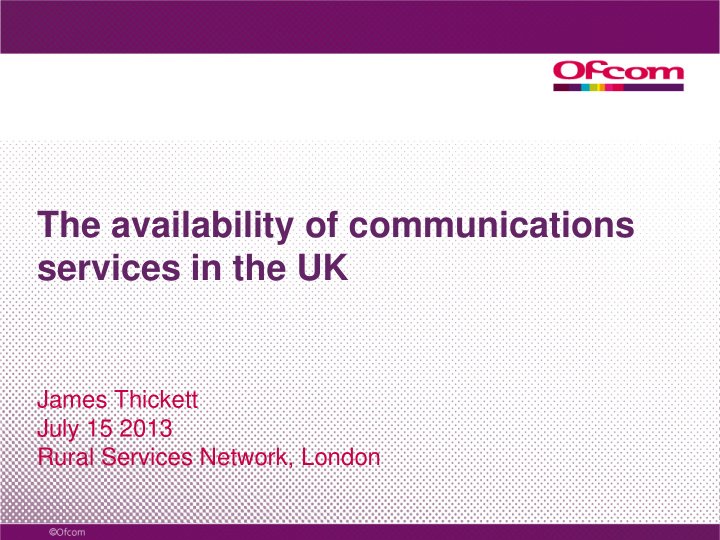



The availability of communications services in the UK James Thickett July 15 2013 Rural Services Network, London
Content • Introduction • Why availability matters • The availability of communications services • The role of markets • The role of interventions • Findings and observations 1
Where there is light there are people Campaign to Protect Rural England 2
3
4
Why availability matters • Access to the internet is a particular concern – For consumers – For citizens – For the economy • Mobile internet availability also matters • Internet availability and quality of service are likely to matter even more in the future • Other communications services • Take-up 5
The availability of communications services • Fixed telephony • Fixed broadband • Mobile (voice and data) • Digital television • Radio • Post 6
Fixed telephony • Universal service obligation – BT and KCom • £3400 threshold for unreasonable cost • More than 99.9% of requests for service fulfilled 7
Standard broadband (% households) 8
Superfast broadband (% households) 9
Availability of superfast broadband in the UK Ofcom 10
Availability of superfast broadband in Europe Point Topic 11
2G mobile (% premises served by at least one operator) 12
3G mobile (% premises served by at least one operator) 13
Mobile (% landmass served by at least one operator) 14
Not spots Land mass Roads 15
Nearly 50,000 do not have either broadband or 3G mobile 16
DTT (% households served by all multiplexes) 17
DAB (% households with BBC coverage) 18
DAB (% households with Digital One coverage) 19
DAB (% miles of road with coverage) 20
Post • Universal service obligation • Collection and delivery six days per week, at uniform prices throughout the UK • Royal Mail was allowed 3,000 delivery exceptions in 2012 • Represents 0.01% of UK addresses 21
The role of markets • The benefits of competitive markets • Market imperfections – High fixed costs – Externalities – Pricing inflexibility – Market power • What drives local availability in practice? – The size of demand in a particular local area – The cost of providing services 22
Average number of cell sites by local authority in Great Britain 23
Cumulative population coverage of the UK DTT network 24
Transmitter sites and radio availability in South Wales 25
Transmitter sites and radio availability in Birmingham 26
The role of intervention • Forms of intervention – Subsidy or public procurement – Service obligations on providers – Facilitation of market-based solutions – Community-based solutions • Intervention in practice – To increase the pace of rollout to commercial levels – To increase coverage beyond commercial levels – To mimic the effects of competition 27
Interventions Department for Culture, Media & Sport Broadband Delivery UK Superfast Cornwall Mobile Infrastructure Project 28
Findings • Rural areas experience lower availability of communications services • Market-led rollout reflects differences in population and geography • Universal service obligations ensure some services are available to all but at the cost of higher prices or taxes • Areas that have not previously benefited from commercial rollout are more likely to experience market shortfalls in the future • Intervention by public bodies and other interested parties can anticipate this • The frameworks for universal availability are best set by elected representatives 29
James Thickett: Director of Nations & Market Developments James.thickett@ofcom.org.uk 30
Recommend
More recommend